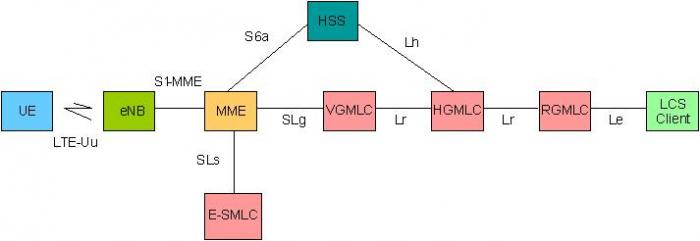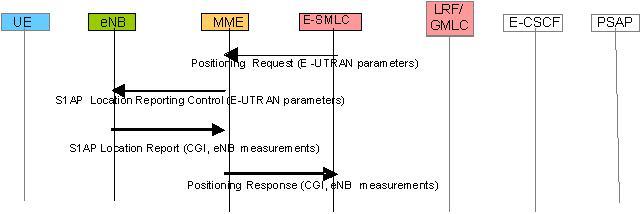3GPP considered 5 architecture alternatives for LCS during study and selected the one explained further according to 3GPP Release 9.
In the LCS architecture, an Evolved SMLC is directly attached to the MME.
The objectives of this evolution is to support location of an IMS emergency call, avoid impacts to a location session due to an inter-eNodeB handover, make use of an Evolved and support Mobile originated location request (MO-LR) and mobile terminated location request MT-LR services.
Release 9 LCS solution introduces new interfaces in the EPC:
- SLg between the GMLC and the MME
- SLs between the E-SMLC and the MME
- Diameter-based SLh between the HSS and the HGMLC
Network Initiated Location Request (NI-LR) Architecture

The shown architecture above supports an NI-LR for emergency calls. Evolved SMLC (E-SMLC) is connected to the MME. E-SMLC is analogous to an NSS based SMLC defined for GSM which is connected to an MSC.. An SLs interface is defined in between the E-SMLC and MME and an SLg interface between the MME and GMLC.
MT-LR and MO-LR Architecture
An extension to the architecture to support an MT-LR and MO-LR is shown below.

Location Procedure between the GMLC, MME and E-SMLC
The location procedure described below supports both an NI-LR for emergency calls and an MT-LR for an external LCS client.

The GMLC sends a location request to the serving MME , If the UE is in ECM-IDLE state, the MME performs a network triggered service request in order to establish a signalling connection with the UE and assign a specific eNodeB.
The MME forwards the location request to the E-SMLC and The E-SMLC performs a positioning procedure (explained below) and returns the resulting location information (e.g. location estimate) to the MME.
The MME returns the location information to the GMLC.
Network Based Positioning Procedure:

The E-SMLC sends a Positioning Request to the MME including parameters for the E-UTRAN defining the type of measurement information required. The MME sends an S1AP Location Reporting Control to the serving eNodeB for the UE and eNodeB returns an S1AP Location report to the MME carrying the CGI and any requested measurements. The MME returns the CGI and measurements to the E-SMLC.
UE Assisted and UE Based Positioning Procedure:

The E-SMLC sends a Positioning Request to the MME carrying an LTE Positioning Protocol (LPP) PDU which may request specific measurements by the UE. MME forwards the LPP PDU to the serving eNodeB in an existing S1AP Downlink NAS Transport
The eNodeB forwards the LPP PDU to the UE in an existing RRC DL Information Transfer message. The UE performs any positioning measurements requested by the LPP PDU and returns measurement information and/or information concerning its capabilities or requested assistance data in an LPP PDU to the eNodeB contained in an existing RRC UL Information Transfer message.
The eNodeB forwards the LPP PDU to the MME in an existing S1AP Uplink NAS Transport message. The MME forwards the LPP PDU to the E-SMLC in a Positioning Response.
